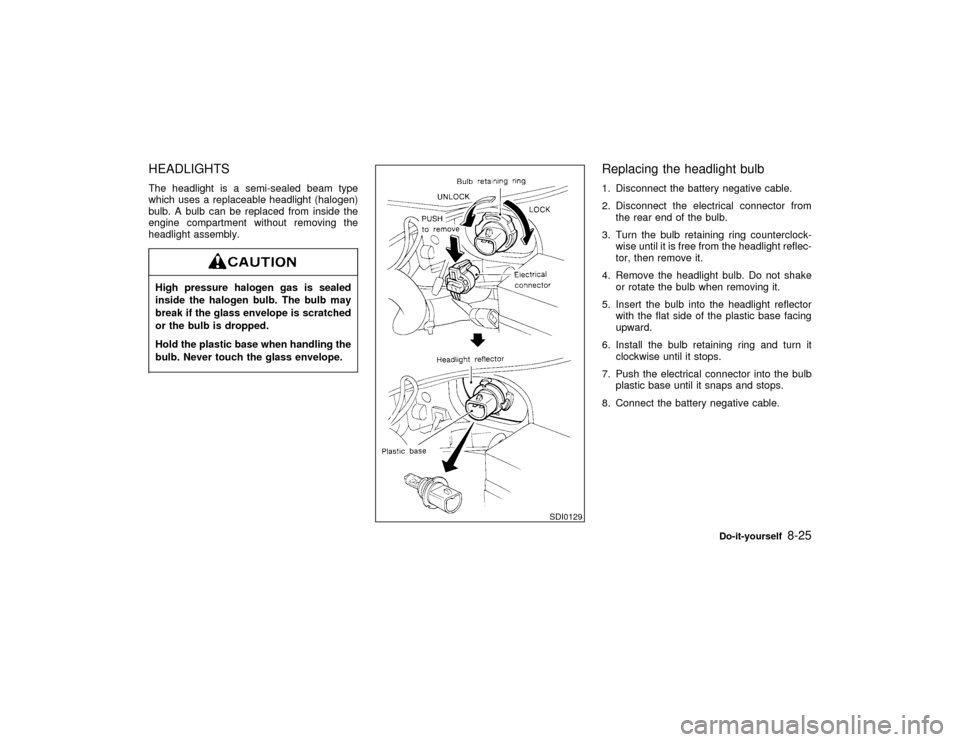1998 NISSAN MAXIMA Battery
[x] Cancel search: BatteryPage 180 of 231

HEADLIGHTSThe headlight is a semi-sealed beam type
which uses a replaceable headlight (halogen)
bulb. A bulb can be replaced from inside the
engine compartment without removing the
headlight assembly.High pressure halogen gas is sealed
inside the halogen bulb. The bulb may
break if the glass envelope is scratched
or the bulb is dropped.
Hold the plastic base when handling the
bulb. Never touch the glass envelope.
Replacing the headlight bulb1. Disconnect the battery negative cable.
2. Disconnect the electrical connector from
the rear end of the bulb.
3. Turn the bulb retaining ring counterclock-
wise until it is free from the headlight reflec-
tor, then remove it.
4. Remove the headlight bulb. Do not shake
or rotate the bulb when removing it.
5. Insert the bulb into the headlight reflector
with the flat side of the plastic base facing
upward.
6. Install the bulb retaining ring and turn it
clockwise until it stops.
7. Push the electrical connector into the bulb
plastic base until it snaps and stops.
8. Connect the battery negative cable.
SDI0129
Do-it-yourself
8-25
Z
01.1.31/A32-D
X
Page 195 of 231

Seats:Check seat position controls such as
seat adjusters, seatback recliner, etc. to en-
sure they operate smoothly and that all latches
lock securely in every position. Check that the
head restraints move up and down smoothly
and that the locks (if equipped) hold securely
in all latched positions.
Seat belts:Check that all parts of the seat belt
system (for example, buckles, anchors, adjust-
ers and retractors) operate properly and
smoothly, and are installed securely. Check
the belt webbing for cuts, fraying, wear or
damage.
Accelerator pedal:Check the pedal for
smooth operation and make sure the pedal
does not catch or require uneven effort. Keep
the floor mats away from the pedal.
Clutch pedal*:Make sure the pedal operates
smoothly and check that it has the proper free
play.
Brakes:Check that the brakes do not pull the
vehicle to one side when applied.
Brake pedal and booster*:Check the pedal
for smooth operation and make sure it has the
proper distance under it when depressed fully.
Check the brake booster function. Be sure tokeep floor mats away from the pedal.
Parking brake*:Check that the lever has the
proper travel and make sure that the vehicle is
held securely on a fairly steep hill when only
the parking brake is applied.
Automatic transaxle P (Park) position
mechanism:Check that the brake pedal must
be depressed for the selector lever to be
moved from the P (Park) position. On a fairly
steep hill check that the vehicle is held se-
curely with the selector lever in the P (Park)
position without applying any brakes.
Under the hood and the vehicleThe maintenance items listed here should be
checked periodically (for example, each time
you check the engine oil or refuel).
Windshield washer fluid*:Check that there
is adequate fluid in the tank.
Engine coolant level*:Check the coolant
level when the engine is cold.
Radiator and hoses:Check the front of the
radiator and clean off any dirt, insects, leaves,
etc., that may have accumulated. Make sure
the hoses have no cracks, deformation, dete-
rioration or loose connections.Brake and clutch fluid levels*:Make sure
that the brake and clutch fluid levels are be-
tween the MAX and MIN lines on the reservoir.
Battery*:Check the fluid level in each cell. It
should be between the MAX and MIN lines.
Engine drive belts*:Make sure that no belt is
frayed, worn, cracked or oily.
Engine oil level*:Check the level on the
dipstick after parking the vehicle on a level
spot and turning off the engine. Be sure to wait
a few minutes to allow the oil to drain back into
the sump.
Power steering fluid level* and lines:Check
the level in the reservoir tank with the engine
off. Check the lines for proper attachment,
leaks, cracks, etc.
Automatic transaxle fluid level*:Check the
level on the dipstick after putting the selector
lever in P (Park) position with the engine idling.
Exhaust system:Make sure there are no
loose supports, cracks or holes. If the sound of
the exhaust seems unusual or there is a smell
of exhaust fumes, immediately locate the
trouble and correct it.
9-4
Maintenance
Z
01.1.31/A32-D
X
Page 221 of 231

Your NISSAN is covered by the following
emission warranties.
For US:
IEmission Defects Warranty
IEmissions Performance Warranty
For Canada:
Emission Control System Warranty
Details of these warranties may be found with
other vehicle warranties in your Warranty In-
formation and Maintenance Log Booklet that
comes with your NISSAN. If you did not re-
ceive a Warranty Information and Mainte-
nance Log Booklet, or it has become lost, you
may obtain a replacement by writing to:
INissan Motor Corporation U.S.A.
Consumer Affairs Department
P.O. Box 191
Gardena. CA. 90248-0191
INissan Canada Inc.
5290 Orbitor Drive
Mississauga, Ontario,
L4W 4Z5
If you believe that your vehicle has a
defect which could cause a crash or
could cause injury or death, you should
immediately inform the National High-
way Traffic Safety Administration(NHTSA)
in addition to notifying
NISSAN.
If
NHTSA
receives similar complaints,
it may open an investigation, and if it
finds that a safety defect exists in a
group of vehicles, it may order a recall
and remedy campaign. However,
NHTSA
cannot become involved in
individual problems between you, your
dealer, or NISSAN.
To contactNHTSA
, you may either call
the Auto Safety Hotline toll-free at
1-800-424-9393 (or 366-0123 in Wash-
ington, D.C. area) or write to:
NHTSA
,
U.S. Department of Transportation,
Washington, D.C. 20590. You can also
obtain other information about motor
vehicle safety from the Hotline.
You may notify NISSAN by contacting
our Consumer Affairs Department, toll-
free, at 1-800-NISSAN-1.
In Hawaii call (808) 836-0888.
Due to legal requirements in some states/
areas, your vehicle may be required to be in
what is called the ready condition for an
Inspection/Maintenance (I/M) test of the emis-
sion control system.
The vehicle is set to the ready condition when
it is driven through certain driving patterns.
Usually, the ready condition can be obtained
by ordinary usage of the vehicle.
If a powertrain system component is repaired
or the battery is disconnected, the vehicle may
be reset to a not ready condition. Before taking
the I/M test, drive the vehicle through the
following pattern to set the vehicle to the ready
condition. If you cannot or do not want to
perform the driving pattern, an NISSAN dealer
can conduct it for you.Always drive the vehicle in a safe man-
ner according to traffic conditions and
obey all traffic laws.1. Start the engine when the engine coolant
temperature gauge needle points to C. Al-
low the engine to idle until the gauge needle
points between the C and H (normal oper-
ating temperature).
EMISSION CONTROL SYSTEM
WARRANTYREPORTING SAFETY DEFECTS
(US only)READINESS FOR INSPECTION/
MAINTENANCE (I/M) TEST (US
only)10-18
Technical and consumer information
Z
01.1.31/A32-D
X
Page 224 of 231

11 Index
A
ABS ................................................................. 5-18
Adjusting the time ........................................... 2-25
Adjustment
Front manual seat ....................................... 1-2
Front power seat ......................................... 1-4
Head restraint .............................................. 1-5
Shoulder belt ............................................. 1-22
Air bag
System....................................................... 1-12
System, Side ............................................. 1-13
Warning label ............................................ 1-15
Warning light ...................................... 1-15, 2-8
Air cleaner....................................................... 8-18
Air conditioner
Automatic..................................................... 4-9
Manual ......................................................... 4-3
Operation, Manual ....................................... 4-5
Servicing .................................................... 4-12
Specification label ................................... 10-11
Air conditioning system refrigerant and
lubricant recommendations ............................. 10-6
Aluminum alloy wheels, Cleaning ..................... 7-4
Anchor point location, Top strap..................... 1-35
Antenna........................................................... 4-25
Anti-freeze, Cold weather ............................... 5-19
Anti-lock Brake System (ABS) ........................ 5-18Appearance care
Exterior ........................................................ 7-2
Interior ......................................................... 7-4
Armrest ............................................................. 1-6
Ashtray ............................................................ 2-19
Audio system .................................................. 4-12
Automatic
Operation, Air conditioner ......................... 4-10
Sunroof, Operation .................................... 2-24
Transaxle fluid ........................................... 8-10
Transmission, Driving .................................. 5-7
Avoiding collision and rollover .......................... 5-3
B
Battery
Cold weather ............................................. 5-19
Maintenance .............................................. 8-14
Replacement, Multi-remote control ............. 3-7
Before starting the engine ................................ 5-6
Belt
Drive .......................................................... 8-15
Extender, Seat........................................... 1-25
Height adjustment, Shoulder ..................... 1-22
Maintenance, Seat .................................... 1-25
Seat ........................................................... 1-17
Brake
Booster ...................................................... 8-21
Fluid ........................................................... 8-12Parking ...................................................... 5-12
Pedal ......................................................... 8-20
System....................................................... 5-17
Warning light ............................................... 2-8
Break-in schedule ........................................... 5-14
Bulb
Checking...................................................... 2-7
Indicator ....................................................... 2-9
Replacement ............................................. 8-25
Warning light ............................................... 2-7
Buzzer ............................................................. 2-11
C
Capacities and recommended fuel/lubricant .. 10-2
Car phone ....................................................... 4-25
Carbon monoxide, Exhaust gas ....................... 5-2
Cassette tape player operation....................... 4-15
Cassette tape player operation, with compact disc
(CD) player type ............................................. 4-21
Catalytic converter, Three way catalyst............ 5-2
CB radio or car phone .................................... 4-25
Ceiling light ..................................................... 2-25
Certification label, F.M.V.S.S. ....................... 10-10
Chain, Tire ...................................................... 8-33
Changing
A flat tire ...................................................... 6-2
Engine coolant............................................. 8-6
Engine oil..................................................... 8-9
Engine oil filter........................................... 8-10
Z
01.1.31/A32-D
X